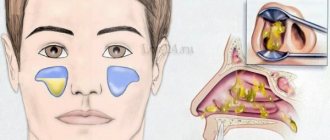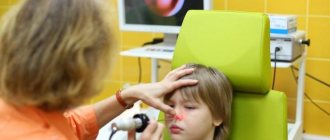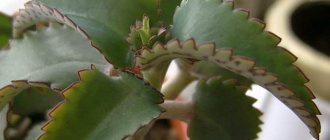Non-puncture method of treating purulent sinusitis, frontal sinusitis, sinusitis
Author:
- Golonova Yulia Yurievna
otorhinolaryngologist, clinic director
Purulent sinusitis, frontal sinusitis, sinusitis is a bacterial inflammation of the paranasal sinuses with the accumulation of purulent exudate (contents) in them.
Anyone who has encountered this problem knows what excruciating discomfort this disease brings, making it incapacitating for a long time.
Signs of purulent sinusitis:
- One- or two-sided nasal congestion;
- Discharge from the nose is yellow-green in color, sometimes with a foul odor;
- Pain in the projection of the maxillary or frontal sinuses (in the infraorbital region to the right or left of the nose, in the frontal region), often intensifying when the head is tilted forward;
- Irradiation (spread) of pain into the upper jaw and the roots of the teeth of the upper jaw is possible;
- Headache;
- Feeling of fullness, congestion in the projection of the sinuses;
- Inability to concentrate;
- Malaise;
- Nasality;
- The disease, as a rule, proceeds either without an increase in temperature, or with an increase to subfebrile levels (37.0-37.8 degrees).
- There may be a cough associated with thick mucus running down the back of the throat;
- Often ear congestion.
Conservative treatment
YAMIK METHOD
For Russian otolaryngology, sinus puncture (puncture) has long been a traditional method of treating purulent sinusitis. This method is considered quite simple and familiar, but, unfortunately, this procedure has many disadvantages. Puncture is an invasive manipulation that does not exclude the occurrence of complications, sometimes even fatal. When performing it, there is a real danger of the needle penetrating into such border areas as the orbit of the eye or the soft tissue of the cheek, infection of these structures and subsequent purulent inflammation.
Often, a single procedure is not enough, and the doctor has to repeat it, and sometimes resort to multiple punctures. In addition, each patient responds differently to such treatment. The fear of this rather unpleasant procedure can be called quite justified. Sometimes there are direct contraindications to its implementation, such as disorders of the blood coagulation system, intolerance to painkillers, and others. The main disadvantage of this procedure is that the doctor can only perform a puncture of the maxillary sinus on an outpatient basis, while in most cases others are also affected.
| PROCEDURE: | PRICE: |
| YAMIK procedure (1 side) | 1500 |
| YAMIK procedure (2 sides) | 2000 |
| YAMIK procedure (1 side) Ph.D. | 2000 |
| YAMIK procedure (2 sides) Ph.D. | 2500 |
The YAMIK method is a controlled local therapy for sinusitis that does not have all of the above disadvantages. When using it, a special device is used, called the YAMIK sinus catheter. The essence of the method is as follows: a sinus catheter creates controlled (either positive or negative) pressure in the nasal cavity, after which the purulent contents of the sinus are pumped out through natural openings (stomachs).
The advantages of the YAMIK method are that its use eliminates injury to the mucous membrane and bone structure of the paranasal sinuses and nasal cavity. In addition, this procedure is completely painless for the patient. The use of the YAMIK method allows you to pump out pus from several sinuses on one side at once, and also reduce swelling of the nasal cavity. Using this procedure, it is possible to deliver medicinal solutions to the area of natural sinus anastomoses (communications of the paranasal sinuses with the nasal cavity), which helps restore the function of these openings and thereby speeds up recovery.
What are the dangers of purulent sinusitis, frontal sinusitis, and sinusitis?
Pus in the sinuses is pus in the skull, in close proximity to the brain, to the eye sockets, which means the greatest danger is the development of complications in these organs:
- Encephalitis
- Meningitis
- Brain abscess
- Orbital abscess
- Orbital phlegmon
These complications are due to the fact that if it is impossible to empty the pus through the natural anastomosis connecting the sinuses with the nasal cavity, blocking the contents in the sinuses, the pus “melts” its way along the nerve trunks and vessels to nearby organs
ear complications often develop
- Tubootitis;
- Exudative otitis;
- Acute otitis media.
Associated with the spread of edema in the nasopharynx to the auditory tubes, closure of the auditory tubes and the accumulation of exudate (fluid) in the tympanic cavity.
How does the yamik procedure work for sinusitis?
- Preparation
A vasoconstrictor is instilled into the nose and local anesthesia is administered with a spray (lidocaine or novocaine). The patient sits down and tilts his head to the side so that the purulent exudate flows out more easily.
- Catheter placement
The catheter body is inserted through the nostril to a depth of approximately 2.5-3 cm. The tube is flexible, so it adapts to the structural features of the nasopharynx. The posterior balloon is placed at the posterior wall of the nasopharynx. After which it swells and blocks the flow of air into the nasopharynx. The anterior balloon is then placed in the nose and inflated in the same way.
- Executing the procedure
A syringe is attached to the working channel. Air is sucked out to create a vacuum inside the nose. To do this, moving the syringe piston back and forth creates different pressures. When the sinus anastomosis opens, purulent fluid comes out of them into the nasal cavity and from there enters the syringe. And so on several times until pus stops flowing into the syringe. If necessary, the patient is placed in a side-lying position and the medicine is injected directly into the nasopharynx through a syringe.
- After the procedure
After the procedure is completed, the balloons are deflated in the same sequence in which they were inflated, and the sinus catheter is removed from the nasal cavity.
How long does it take to treat sinusitis with a pit catheter?
The procedure itself takes no more than 8 minutes. For complete cure, 3-6 procedures are prescribed depending on the form and course of the disease.
When yamic treatment is not suitable
If the pus does not flow into the syringe, this may mean that there is no pus in the sinuses or that the sinus anastomosis is blocked, and this method of treatment will not help.
Pus in the paranasal sinuses, what to do?
The gold standard for solving this problem was and remains puncture of the maxillary sinuses or trephine puncture of the frontal sinus with rinsing with sterile saline and injection of an antiseptic or fluimucil with an antibiotic into the vacated sinus.
But, due to the fear of invasive treatment methods or with an isolated process in the frontal sinus, the only adequate alternative to puncture is the extraction of purulent contents using a Yamic catheter.
Pros and cons of YAMIK treatment
Washing the nose for sinusitis using a YAMIK catheter has more advantages than disadvantages, so the procedure is quite common.
| Advantages | Flaws |
| No pain | Impossibility of rinsing with a deviated septum |
| No damage to the mucosa or loss of bone integrity | The complexity of the procedure for nasal polyps |
| Effective after one application |
Patients often ask what is better: YAMIK or puncture, YAMIK or “cuckoo”. It is impossible to answer unequivocally, because the answer depends on each specific case. Many patients prefer YAMIK to the “cuckoo” due to less discomfort and ease of implementation. If you choose between a puncture and a YAMIK catheter, then lavage is first prescribed and only if it is ineffective or there are contraindications to it, a puncture is performed. The final decision remains with the ENT doctor.
Technique of the treatment procedure with a yamic catheter:
Before the procedure, swelling in the nose is removed with vasoconstrictors, then the otorhinolaryngologist anesthetizes the surface of the mucous membrane using an anesthetic in the form of a spray or by application (by inserting a probe with a cotton pad soaked in anesthetic into the nasal cavity for 5-10 minutes). Using a probe, the depth of the patient’s nasopharynx is also measured, along which the distance of the most appropriate location of the anterior coupling of the pit catheter is measured.
After anesthesia, a Yamik catheter is inserted into one of the halves of the nose and air is introduced into one of the halves of the nose using a disposable syringe through a system with a nipple, first into the rear balloon (which closes the space of the nasopharynx), then into the front coupling, which hermetically closes the vestibule of the nose (at the level of the wing of the nose). This way, one half of the nose is hermetically sealed.
The patient sits on a chair with the head tilted at an angle that facilitates the passage of discharge through the natural anastomosis of the paranasal sinuses.
Using a disposable syringe, negative pressure is created through a free catheter in the anterior coupling in the cavity of the blocked half of the nose, which helps to stretch and free all sinuses on this side from pus.
At the end of the procedure, an antiseptic is injected into the sinuses through a catheter.
Treatment of sinusitis without puncture - YAMIK
Treatment of sinusitis without puncture - YAMIK The upper respiratory tract is most often susceptible to various seasonal infections. It is with a runny nose and nasal congestion that ARVI or influenza begins.
As a rule, we do not attach much importance to inflammation of the sinus mucosa, because pharmaceutical products easily relieve swelling and other symptoms of ENT disease. Serious problems with the upper respiratory tract are detected when the disease has already progressed. Nasal congestion does not go away after using the drops, the temperature rises, headache and pain in the bridge of the nose are the first symptoms of sinusitis . Treatment of sinusitis without a puncture - YAMIK Sinusitis of each sinus has its own name. One of the most common types of sinusitis is sinusitis (inflammation of the maxillary sinus). Sinusitis occurs as a complication of past infectious diseases. Treatment is based on taking antibiotics and rinsing the sinuses with antiseptics. Unfortunately, such therapy does not always bring a complete cure for the disease and sinusitis progresses to the chronic stage. In this case, surgical intervention (puncture of the sinuses) and further therapy are required.
The Levita Clinic offers an effective method of non-puncture (no puncture) treatment of sinusitis and other sinusitis using the YAMIK method. The method is based on non-surgical puncture and drug therapy, which, of course, allows the patient to avoid surgical intervention. The uniqueness of YAMIK lies in the fact that all sinuses located on one side are involved in the treatment. This approach to the treatment of sinusitis is much more effective, because inflammation does not always have a single localization, but spreads to several sinuses.
The essence of the method is to use a special catheter to pump out mucus from the inflamed nasal sinuses and into
pour the medicinal solution into the vacant space. The YAMIK sinus catheter, developed by Russian scientists, is made of silicone, which avoids injury during therapy.
Before the procedure, the doctor lubricates the nasal mucosa with a light anesthetic. After this, the catheter is carefully inserted into the nasal opening. By creating negative pressure in the nasal cavity using a catheter and syringe, the doctor clears the sinuses of mucus and fluid. The patient is then placed on a couch and a drug is injected through a sinus catheter into his inflamed sinus.
We also recommend Hearing loss (Hearing loss)
For successful treatment, several YAMIK catheter procedures are required. This technique is completely harmless and painless, which is why it is often prescribed for the treatment of sinusitis in children. If we talk about contraindications, the list is short:
- severe curvature of the nasal septum;
- nasal polyps;
- vasculitis;
If you want to undergo treatment for sinusitis without a puncture in Butovo, then we suggest contacting our clinic. To carry out the procedure, it is necessary that the doctor has experience in this field - after all, the success of treatment often depends on the correct and clear actions of the ENT doctor. The otolaryngologist at our clinic, Yakimov A.V., has extensive medical practice in both adult and pediatric otolaryngology. He treats sinusitis with a YAMIK catheter in Butovo, at the LeVita clinic. Treatment of sinusitis in a clinic in Butovo using the YAMIK method will help you get rid of sinusitis and other types of sinusitis forever.
Answer
- llevita
- ENT
Where can you get puncture-free treatment using a pit catheter:
In specialized ENT clinics or ENT offices that provide such a service, in which ENT doctors have the skill of treating purulent sinusitis , sinusitis, sinusitis using the Yamik-catheter method, in Moscow this can be done in ENT clinic number 1.
Non-puncture treatment of inflammation of the paranasal sinuses with a YAMIK catheter on one side 3500 rub. Non-puncture treatment of inflammation of the paranasal sinuses with a YAMIK catheter on both sides 5000 rub.
If you or your loved ones suffer from purulent sinusitis, frontal sinusitis or sinusitis and are afraid to go to an ENT doctor for traditional puncture treatment, remember that the cost of hesitation is too high, choose a puncture-free treatment method using a Yamik catheter, start treatment as early as possible and withdraw yourself from the area of high risk of life-threatening complications!
YAMIK-catheter
The non-puncture Yamik method has recently become widely used in the treatment of sinusitis. This ENT procedure was invented by the doctor V.S. Kozlov. The point of the procedure is that it allows you to treat sinusitis without a puncture.
Conservative treatment of sinusitis involves puncturing the sinuses and washing them with antibiotics and mucus thinners - this procedure is painful, the recovery process is long, but, as a rule, even in the past, this method was resorted to in extreme, advanced cases. Therefore, the emergence of a way to treat sinusitis without a puncture was a real breakthrough in medicine.
Yamik method - the principle of the procedure is to “suck out” the contents from the paranasal sinuses. In this case, the process is considered natural, because no surgical intervention occurs. The walls of the sinuses are not injured, since the pit catheter is made of soft latex. In addition to treating sinusitis, this method is used for frontal sinuses. Yamic catheters come in several varieties. Their main difference is the diameter of the channels. After all, it is impossible to perform the procedure on a child with the same catheter as on an adult.
YAMIK catheter device
The YAMIK catheter is a small system that consists of a body and a cuff. The body consists of:
- Rear cylinder
- Balloon inflation valve
- Metal rod
The cuff consists of:
- Front cylinder
- Balloon inflation valve
- Working channel
- Syringe adapter
The procedure is carried out in several stages, but lasts only no more than 8 minutes. It is done on an outpatient basis, without special complex preparation of the patient. The Yamik method is well tolerated even by children.
Preparation for the procedure
During the Yamic catheter procedure, the patient is positioned sitting. The doctor anesthetizes one or both (for bilateral sinusitis) sides of the nose. In this case, the inner mucous membrane of the nose is also subjected to anesthesia. After the medicine has taken effect, the sinus catheter is adjusted to the structure of the nasal cavity of a particular patient. This is easy to do, since the catheter has a plastic rod that can be bent. Then, under the careful supervision of a doctor, the Yamik catheter is inserted into the nasal cavity. It is more convenient to do this along the lower part of the nasal canal. Once the posterior balloon is in the nasopharynx, it is inflated by introducing air into it. This is done using a syringe. This completes the preparation for the procedure.
Carrying out the procedure
Before the procedure, the nasal cavity is treated with special vasoconstrictors. Then a latex sinus catheter is inserted into the nasal cavity on one side. After the balloons are inserted, one of them begins to gradually inflate inside the nasopharynx, and the second in the nostril. The patient tilts his head at a certain angle. A small syringe is used to suck out the contents of the maxillary sinuses - pus, mucus. This is how the first stage of the procedure occurs.
Then the medicinal solution contained in it is injected with another syringe. The patient now tilts his head in the opposite direction and as a result, the solution is pumped into the freed sinuses. At this point, the procedure is completed, and the sinus catheter can be removed from the nose. But if the patient suffers from bilateral sinusitis, then it is necessary to repeat the entire procedure, but now on the other side.
Benefits of the procedure
The most important advantage of the Yamik-catheter treatment procedure for sinusitis is its painlessness. The absence of punctures and damage to the sinuses and the inside of the nose allows the patient to immediately recover after the procedure. The therapeutic effect during the procedure is multifaceted; it affects all paranasal sinuses at once.
Therefore, this method can be used to treat not only sinusitis, but also frontal sinusitis, polysinusitis, sphenoiditis, and ethmoiditis. Due to the fact that this method is gentle, it is used to treat pregnant women and small children. Almost all patients tolerate the procedure calmly and throughout the existence of this method, patients have only received positive feedback after treatment. In addition, doctors also recognize the Yamik method as the best at the moment, excluding advanced forms of sinusitis.
Yamic catheter and treatment of children
The Yamik-catheter procedure for the treatment of sinusitis and other nasal diseases in children is almost the same as in adults. To carry out the procedure, a catheter with a small diameter of channels and balloons is used. However, unlike adult patients, a child must be prepared mentally. After all, a child may react negatively to the doctor’s attempts to insert a catheter into his nose. Parents must explain to the child in advance the full meaning of the procedure at a level accessible to the child. The doctor’s task is to turn the procedure into a game, distracting the child from feelings of fear and discomfort. Catheterization of the children's sinuses is actively used in modern otolaryngology. In this case, all anatomical features of the structure of the child’s nasal sinuses are strictly taken into account. This is the only way the procedure will not leave bad memories for the child.
To obtain a lasting effect and consolidate the result of treating sinusitis with a Yamik catheter, it is necessary to carry out at least 2 procedures, and preferably 8 of them. Most often, 3-4 sessions are prescribed, which is often enough to achieve the desired result.
On the subject: How to quickly get rid of colds and runny nose?
Indications and contraindications
The indications for performing the Yamik catheter procedure are as follows:
- Sinusitis
- Acute frontal sinusitis
- polysinusitis
- ethmoiditis
- sphenoiditis
- preparation for serious ENT operations
- the occurrence of purulent sinusitis after surgical operations
The procedure is contraindicated in the following cases:
- hemorrhagic vasculitis
- total polyposis of the inner lining of the nose
- old age
Thanks to the emergence in otolaryngology of the ability to treat sinusitis non-surgically, treatment of the disease and recovery from it have become much less time-consuming. In terms of effectiveness, procedures performed with a YAMIK catheter are superior to conservative treatment methods.











